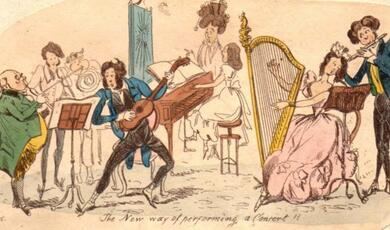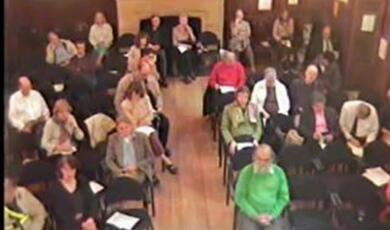The Composer Virtuoso - Liszt’s Transcendental Studies
Share
- Details
- Transcript
- Audio
- Downloads
- Extra Reading
A discussion with Professor Jim Samson (Royal Holloway, University of London), author of the award-winning Virtuosity and the Musical Work. Why did Liszt compose three different versions of this monumental piano work, and what can we learn about 19th-century virtuosity, musical thought and practice from its pages?
Download Transcript
Professor Adrian Thomas
I'm joined today by my colleague, Professor Jim Samson. Those of you who were here for the first lecture will know that it's subtitled 'Musical Thoughts and Afterthoughts' and in a way, that general title for the series is highly appropriate for today's session because we're literally talking about thoughts and afterthoughts with regard to one particular piece.
The first 3 lectures in this year's series are essentially about piano music and about the role of Virtuosity and the Virtuoso performer, the composer-performer. Today our subject is Liszt's Transcendental Studies, which is the most familiar version of the 3 that Liszt composed and therefore we tend to refer to it as being the one that we know best of all.
Jim Samson is Professor of Music at Royal Holloway, University of London. Prior to that, he was Professor at Bristol and before that at Exeter. We go back more decades than I care to remember because we did our first graduate studies together at Cardiff University, where I'm now based. He's the author of a goodly number of very important books. He's written a monograph on Szymanowski and he wrote a very important book about late 19th and early 20th century music called 'Music in Transition'. He's perhaps best known today as one of the eminent world authorities on Chopin, having edited and written books on Chopin over the last 20 years or so, and he's on the editorial team of the 'Chopin Critical Edition' which I mentioned in passing 3 weeks ago.
Although we are going to come on to Liszt, I just want to take this opportunity, Jim, to ask you, why you are interested in Chopin.
JIM SAMSON
Poland, I suppose, was the connection. My first interest was in contemporary Polish music, I mean music since the 1950s onwards. That was where I started. At that time, I was composing rather more than writing scholarship, and then I moved backwards. I lost interest in that a bit and moved to Szymanowski. By this time I got generally very interested in Poland and it seemed that the next logical step to take was Chopin. As a composer, I very much loved playing, in my amateurish sort of way. As a young student at the time there wasn't really any very major study of Chopin in English so it seemed to me that this was a ground that needed tilling and I wrote about 5 or 6 books in the end on Chopin before finally leaving that.
ADRIAN THOMAS
What would you say was the major difference in Chopin scholarship before you started and since you and other colleagues have completed quite a substantial piece of work?
JIM SAMSON
Well, there hadn't really been a very detailed study of the Chopin sources, for example. By sources I mean here manuscript sources but also early printed sources. I don't think we want to get too far into this now, but source tradition is enormously complex. If you are investigating any one piece of Chopin, either in terms of how it came to be the way it is, or in order to prepare an edition of it, you will find that stretched out on several tables in front of you there will be many different versions with variants and so on that you have to make a choice between. Some of them manuscript autographs or scribal copies, many of them early printed sources. For example, there were 3 first editions of Chopin. Every piece was produced both in Paris, also in Leipzig and also in London, and these 3 first editions very seldom agree and, to make it even more complicated, for any one of those 1 st editions you will find that there are many later impressions. That is to say, a piece would be brought up maybe in quite a small print run, maybe just 50 copies, and then a month later another impression would be made of it with the same plate numbers. The real problem here is locating these because there's nothing to tell you, when you get a first edition from somewhere, which impression it is. You just have to compare them all.
ADRIAN THOMAS
It does reveal the problems of dealing with music as recently as the 19th century and Chopin and Liszt were more or less contemporary. Liszt was, I think, 18 months younger than Chopin. Why Liszt? Was it simply a leap across because they were contemporary and they shared issues?
JIM SAMSON
I was interested in the fact that they both took very different attitudes to their musical work. Given that they both came from the same stable of early 19th century pianism generally, with Chopin I think one would say that he was interested in constantly refining a piece. His instinct, every time he saw a piece of his, was to make a change to it, to refine it, to get it ever more perfect. He couldn't leave it alone. Even when something was in print, i.e. already in the public domain, his tendency would be to grab it and with a pen and ink make changes to it. That was his approach.
Liszt's approach, I think, was really rather different. Coming from the same stable, as I say, but someone who, when dissatisfied with a piece, would be less inclined to revise it and refine it but rather, and in a way this brings us right on to our topic, to make another version of it. So what you get in Chopin, putting it rather crudely, is mini-variance of the same piece. What you get in Liszt are different versions, recompositions of the same piece. I was interested in that sort of contrast and I also had rather grand ideas at the time that I might just embrace 19th century pianism in my writing by doing Chopin and then doing Liszt. That proved to be, I think, an over ambitious idea and having written this one book on Liszt, I've now moved on to other things altogether.
ADRIAN THOMAS
Well, you mentioned the book. This is the book which provoked my invitation for Jim to come along here today, ' Virtuosity and the Musical Work: The Transcendental Studies of Liszt', published by Cambridge University Press last year. On the cover is part of a sketch by Leonardo da Vinci called 'The Bolting Horse', the significance which will appear later, and this book won the award from the Royal Philharmonic Society Book Award in May of this year. It is a wonderful piece of writing, challenging many of the perceived assumptions about how we look at 19th century music in general and the place of Liszt in that particular continuum.
But, my first question to you, Jim, is this: why did you choose a work like the Transcendental Studies when perhaps there are better known pieces by Liszt or even by other composers. Did the composition come first or did the context of the composition come first in your mind?
JIM SAMSON
There are two ways of answering that, one a rather narrow one which is that when you are starting a research project on anything, you have to know what's been done by other people. Now, my first instinct was to look at another piano work of Liszt's but I did discover that other people were doing very substantial work on the sources so one stays away from that.
What really intrigued me about the Transcendentals is that I think more than any other single set of works by Liszt, this one really embraces, more or less, his entire compositional career. Quite literally, from the age of 15, when he wrote the first little exercises on which the Transcendentals are based, right through to almost 50 years later, when he was a very old man and did the final version of Number 4 of these pieces. So, you can actually track this right through his career over almost a 50 year period and it is rather unusual to be able to see a composer working with essentially the same materials over a very long period.
Also, the Transcendentals seem to me a very good peg on which to hang a number of general thoughts I was having about the relationship between performance and composition, performances and works; the whole theme of Virtuosity. So, although the Transcendentals are at the centre of this book, it is probably best to think of them as kind of a thread that runs through, opening up a number of larger questions that already had to do with 19th century music in general.
ADRIAN THOMAS
So, somebody reading the book will get the specifics about this piece but will also be able to extract principals and ideas which may be applicable to other works and composers of the same period.
JIM SAMSON
Well, that was the intention. Whether it's realised or not, I don't know.
ADRIAN THOMAS
Maybe we should just make clear the piece of music we are talking about today, Liszt's Transcendental Studies. There are basically 3 versions:
the ones that he wrote in 1826, when he was in his mid-teens, 'The Study in 12 Exercises', and then he revisited it 11 years later in a piece called 'La Grande Etude', 'The Great Studies', The in 1851, we have the 3 rd level, 'The Studies of Transcendental Execution', which are very closely related to the early ones.
So, we're talking about 3 stages, and one of them, which we'll come to last this afternoon, 'Mazeppa', has got some intervening and final versions which Professor Samson will tell us more about at a later stage.
Let's start with the 1826 ones. Here's a young man, he's hardly a man, he's 14, 15 and he's writing studies which, I imagine, would normally be in the area which teachers would write for their students and yet here you have a young man writing them. That must have been rather unusual at the time.
JIM SAMSON
Well, indeed, and of course, Liszt dedicated these pieces to his teacher who was the very well known figure; any of you who have ever played the piano will know this man, Czerny. You'll remember all those hundreds of ghastly exercises that you had to work through. So, Liszt studied with Czerny and it's somehow rather fitting that he should have dedicated these pieces to Czerny, though as you say, it's rather ironic that it's the pupil writing the studies which one might associate mainly with the teacher.
But certainly these little pieces owe quite a bit to Czerny himself and also quite a bit to composers like Cramer who had written a set of studies that almost everyone in the early 19th century worked on, including Beethoven and the great figures. These were studies that were on just about every piano. It was a time when the classroom and the concert hall were, in a sense, meeting through the genre of the Etude. It was a time in which conservatories were springing up all over Europe and when the piano and pianism was a growth industry, really, both in the concert halls and also in the homes. This is the time when people were starting to learn piano. So, there was really a great need for these kinds of these studies.
There's no doubt at all the Liszt learned more from Czerny than just how to play the piano. By the way, I should say that Liszt was a great supporter of Czerny in later years. Czerny went terribly out of fashion, for reasons that are not hard to imagine, and Liszt was a great defender, probably in some cases even slightly against his better judgement. He was loyal to Czerny.
A number of the little Liszt exercises draw on exercises from Cramer. I'm not trying to make some charge of plagiarism stick here. We need to bear in mind that Liszt is a composer of some 14 or 15 years old and any composer of 14 or 15 years old is almost by definition a derivative composer and he is, quite properly, using models to construct his pieces. What I'm trying to show you is how close he was to some of those models.
ADRIAN THOMAS
I find the series of the early set actually rather intriguing and delightful. They're very light hearted. Do you think that the first set of exercises, as he called them, had he not developed them later, would have stood the test of time? What would we think of them if they were the only version?
JIM SAMSON
I don't think they would have, as you put it, stood the test of time though I actually think they are rather good. But, I wouldn't say they're any better than a whole host of others. I mean, there were a huge number of pieces of this kind being produced in the early 19th century. If I started rattling off the names of pianists-composers, all these figures producing huge numbers of pieces of this kind, Liszt's are perfectly respectable but I wouldn't say that they would still be with us today. Actually, they're not really still with us today, no one plays them.
ADRIAN THOMAS
However, you can find recordings of the various stages, if you look around, of this piece, but NAXOS is doing a complete list. BBC Music Magazine carried a review of this particular issue of the first version. So you can actually follow these through on your own, but this one also has the added benefit of having a version of the 1840 Mazeppa version there as the final track and Professor Samson tells me that he's not aware that it's been recorded before. So, you can find these things on record but, as you say, we don't hear them in the concert halls. Would these have been intended to be performed as a set or were they just exercises for private consumption?
JIM SAMSON
Well, that's a very difficult one to answer. I think the tendency these days from our perspective, is to always think in terms of sets. We think about the Chopin Preludes as a set, they are performed as a set, similarly with the 2 sets of Chopin Etudes. In fact, if you look at early 19th century practice, it was much more common, whether in the concert hall or, indeed, in the salon, to play things individually. Mazeppa's would be extracted from a set of 4, even Preludes would be extracted. We've slightly lost that sense.
This would take me into a whole area that we probably haven't time to explore which is the kind of concert practices and programming of the early 19th century; very different from our world today. We tend to think in terms of structured programmes, with an implicitly educative quality to them. A programme in the early 19th century, certainly for a benefit concert or salon, would be a huge musical feast, all kinds of things in there, and we need to bear in mind there wouldn't have been any piano recitals. That's a later development. Piano recital really dates from the mid 19th century. So, any concert involving a piano would have had to have singers there as well and that was an absolute requirement.
Liszt, curiously enough, was the first person to start playing the piano alone on the concert stage. There's a letter dating from 1840 in which he describes this and says: 'Can you believe it? Can you believe what I've just done? I did a concert on the piano by myself.' 'Le concert se moi'. This was a truly extraordinary thing to do at that time, so one does have to exercise a little bit of historical sympathy and understanding to work yourself back into that world. Even things like piano concertos would not have been played straight through the way we do them today. They may not have even been played with an orchestra, more commonly with a string quintet or as solos and their movements would have been broken up perhaps by a group of songs or something of that sort; a very different world.
ADRIAN THOMAS
Should we move on to the middle of the 3, the 'La Grande Etudes'? Now, 11 years separate these. He's now in his mid twenties, still a young man but the difference between these and the first set is enormous, isn't it?
JIM SAMSON
Absolutely, yes.
ADRIAN THOMAS
What is the nature of that difference?
JIM SAMSON
Well, the nature of it really is that at this point Liszt is setting out with an agenda which is to conquer the concert halls of Europe. He's beginning his 10 years or so of touring absolutely all over Europe. Wherever you visit in Europe, Liszt has been there before you and has given a recital. He was setting out to write music that was so formidably difficult to play that virtually no one else could touch it. That was his agenda and these pieces are, even today, virtually unplayable in certain respects.
Concert pianists today will tell you that there are details in them which you just have to fudge because they're not really properly playable.
This event was on Thu, 18 Nov 2004
Support Gresham
Gresham College has offered an outstanding education to the public free of charge for over 400 years. Today, Gresham plays an important role in fostering a love of learning and a greater understanding of ourselves and the world around us. Your donation will help to widen our reach and to broaden our audience, allowing more people to benefit from a high-quality education from some of the brightest minds.


 Login
Login






